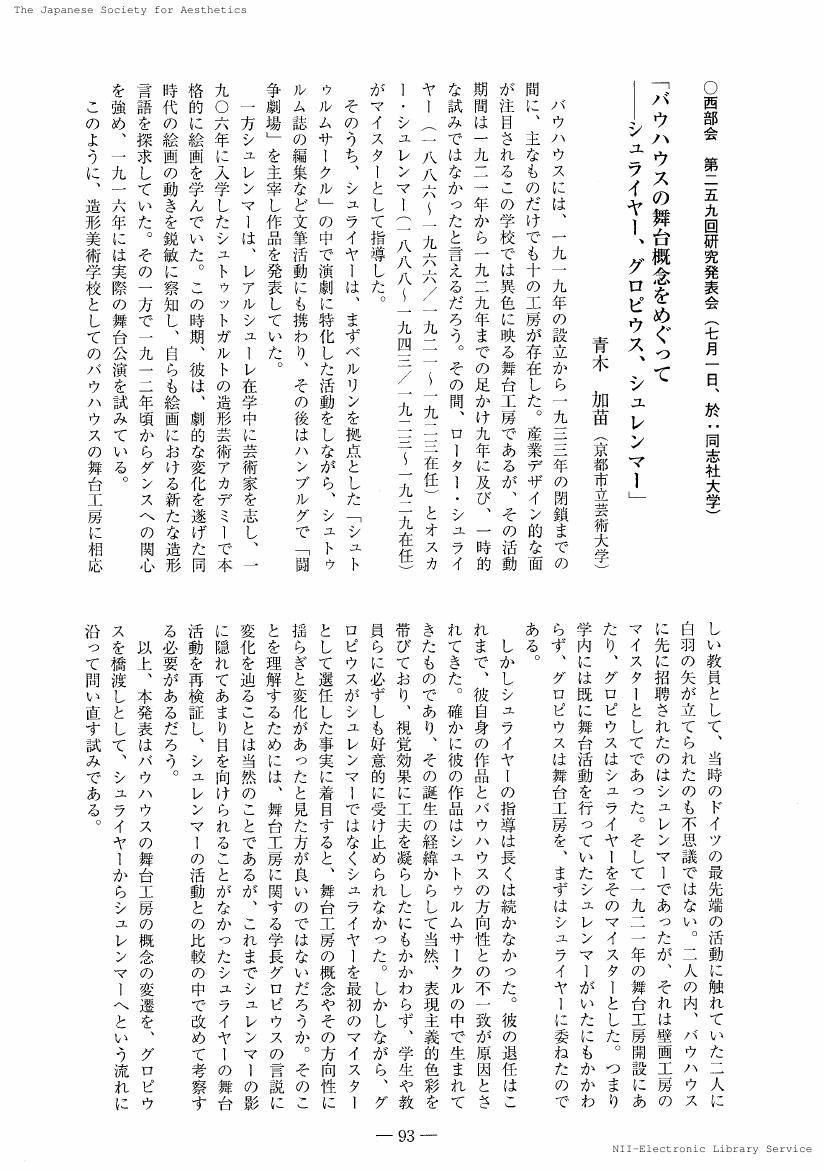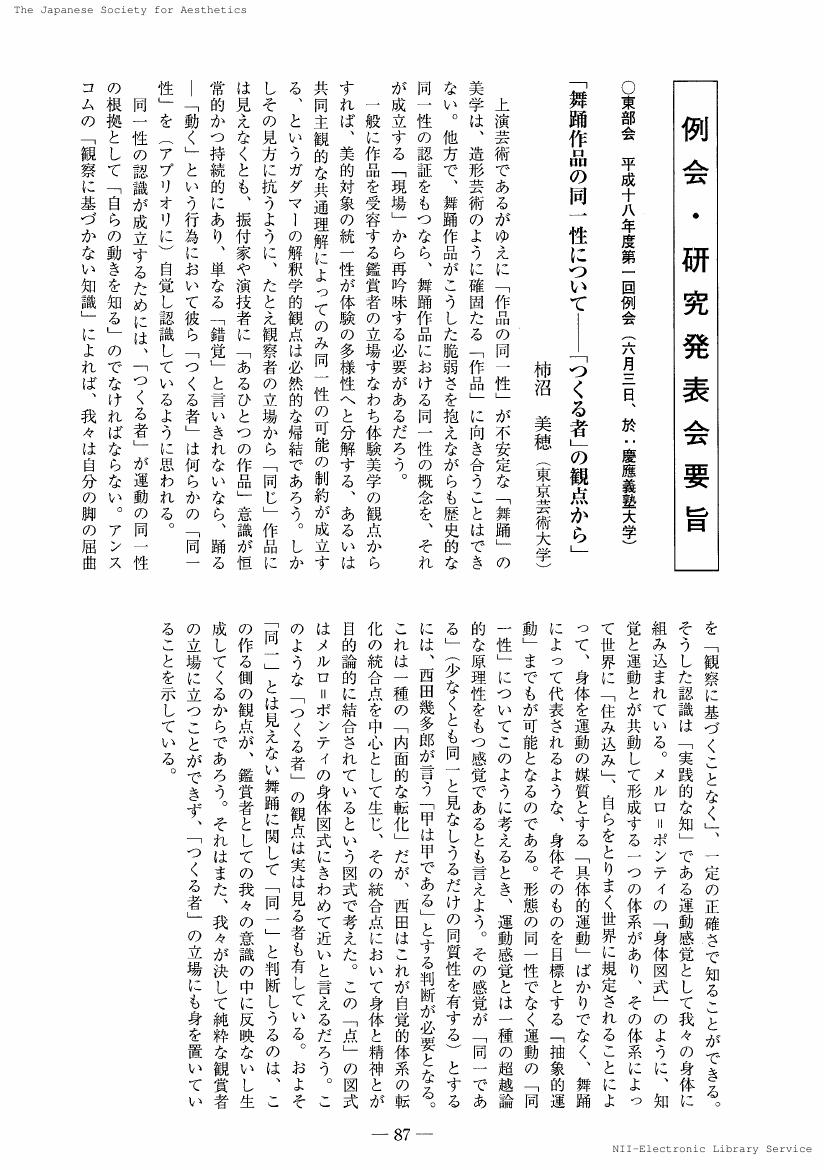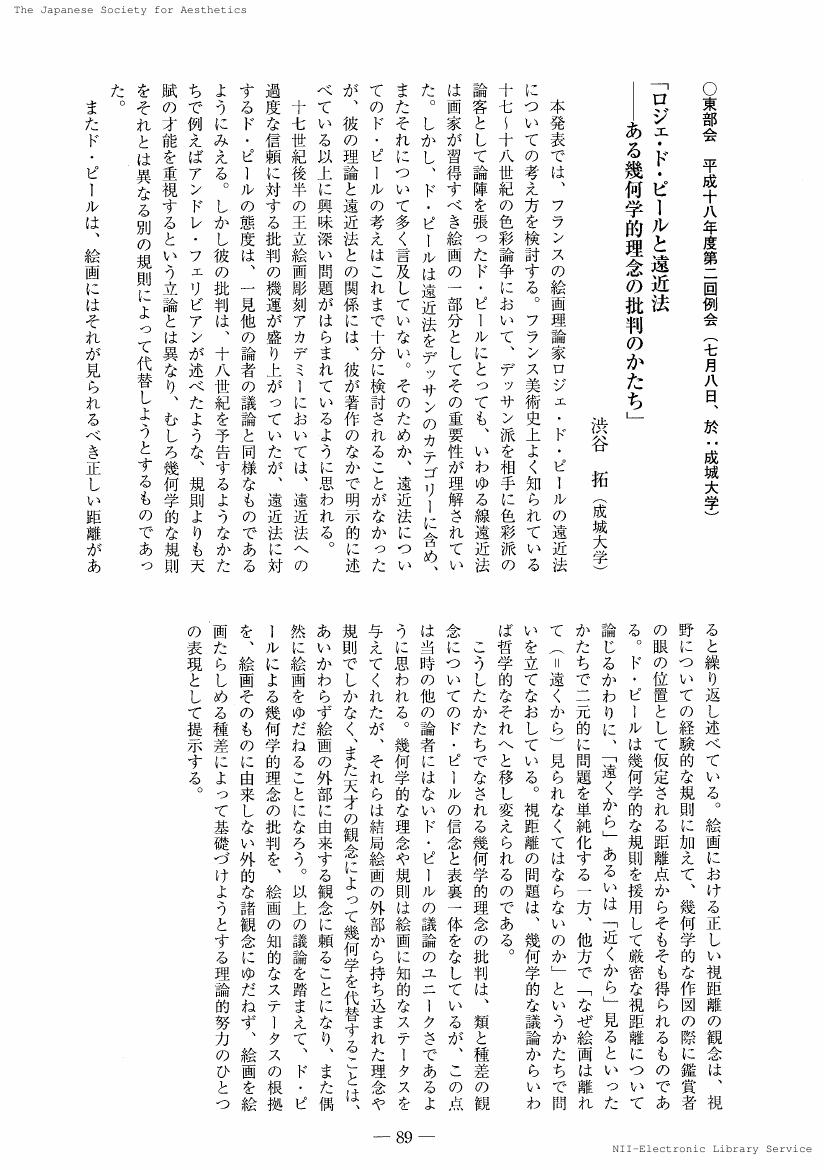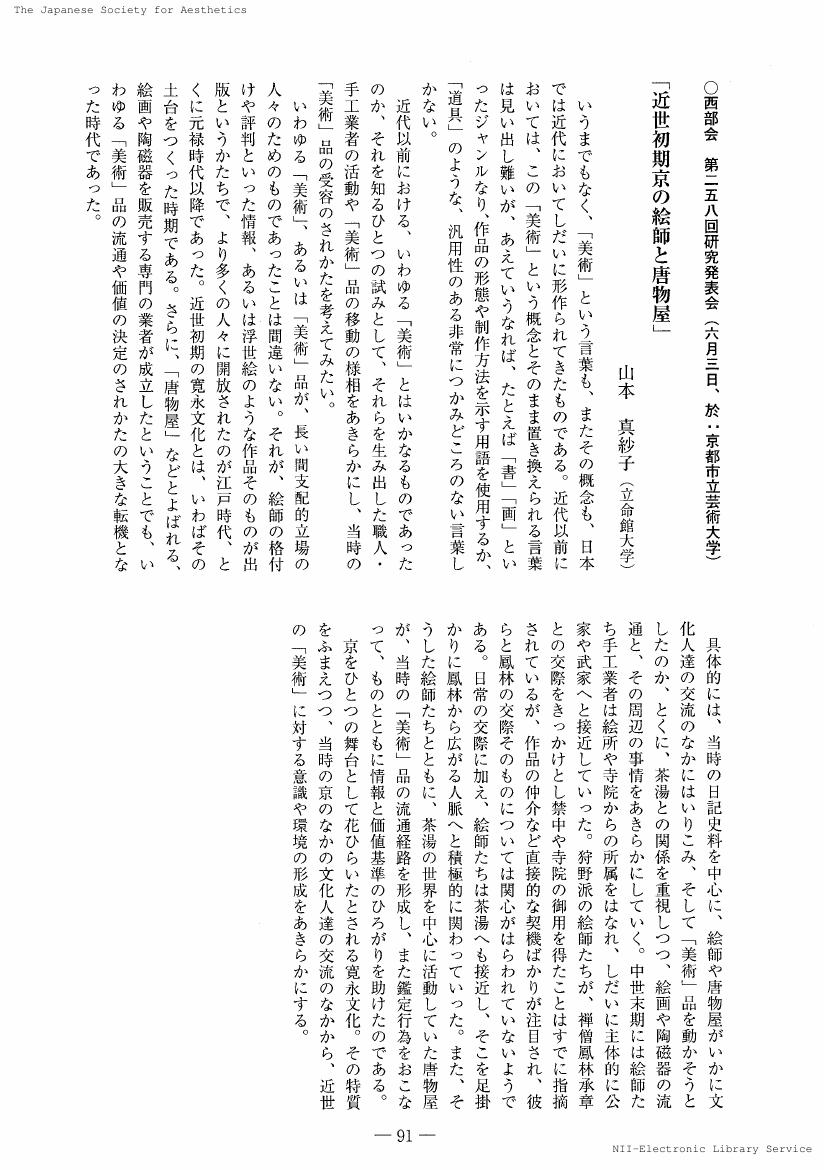- 著者
- 呉 永三
- 出版者
- 美学会
- 雑誌
- 美学 (ISSN:05200962)
- 巻号頁・発行日
- vol.57, no.3, pp.55, 2006-12-31 (Released:2017-05-22)
- 著者
- 大石 昌史
- 出版者
- 美学会
- 雑誌
- 美学 (ISSN:05200962)
- 巻号頁・発行日
- vol.57, no.3, pp.56, 2006-12-31 (Released:2017-05-22)
1 0 0 0 OA アントン・マウフェのラーレン時代(第五十七回美学会全国大会発表要旨)
- 著者
- 太田 靖子
- 出版者
- 美学会
- 雑誌
- 美学 (ISSN:05200962)
- 巻号頁・発行日
- vol.57, no.3, pp.57, 2006-12-31 (Released:2017-05-22)
1 0 0 0 OA 写真と指示 : その類比についての分析の試み(第五十七回美学会全国大会発表要旨)
- 著者
- 岡本 源太
- 出版者
- 美学会
- 雑誌
- 美学 (ISSN:05200962)
- 巻号頁・発行日
- vol.57, no.3, pp.58, 2006-12-31 (Released:2017-05-22)
- 著者
- 小倉 康之
- 出版者
- 美学会
- 雑誌
- 美学 (ISSN:05200962)
- 巻号頁・発行日
- vol.57, no.3, pp.59, 2006-12-31 (Released:2017-05-22)
1 0 0 0 OA 「類似」概念の実効性(西部会第二五八回研究発表会,例会・研究発表会要旨)
- 著者
- 秋庭 史典
- 出版者
- 美学会
- 雑誌
- 美学 (ISSN:05200962)
- 巻号頁・発行日
- vol.57, no.2, pp.92, 2006-09-30 (Released:2017-05-22)
- 著者
- 青木 加苗
- 出版者
- 美学会
- 雑誌
- 美学 (ISSN:05200962)
- 巻号頁・発行日
- vol.57, no.2, pp.93, 2006-09-30 (Released:2017-05-22)
- 著者
- 金 正善
- 出版者
- 美学会
- 雑誌
- 美学 (ISSN:05200962)
- 巻号頁・発行日
- vol.57, no.2, pp.94, 2006-09-30 (Released:2017-05-22)
1 0 0 0 OA 八世紀日本彫刻の彩色材料 : 材料の性質と適性に関する問題を中心に
- 著者
- 國本 学史
- 出版者
- 美学会
- 雑誌
- 美学 (ISSN:05200962)
- 巻号頁・発行日
- vol.57, no.3, pp.1-14, 2006-12-31 (Released:2017-05-22)
The original coloring materials are remaining at arts and crafts in the 7th century to the 8th century, those coloring materials have been keeping use for ornaments of arts and crafts till the 17-18th century. In documents of the 7-8th century we can find many descriptions about coloring materials, it appears there was limitation to use coloring materials. I try to point out the reason of restriction to use coloring materials that is because of chemical character. There is no research which analyzes quality and characteristic of coloring materials themselves, and insists that chemical changes and chemical reactions cause restriction to use of coloring materials. Even if we analyze optically arts and crafts, we can't point out what coloring materials were used to perfectly. So it's necessary to refer documents which record how the coloring material was used, and in which amount used. In consideration of descriptions of documents and decorations examples of arts and crafts and chemical character of coloring materials, I would like to indicate that the restrictions to use of coloring materials are caused by the compatibility and the aptitude of the coloring material.
1 0 0 0 OA バウハウスの舞台概念をめぐって : シュライヤー、グロピウス、シュレンマー
- 著者
- 青木 加苗
- 出版者
- 美学会
- 雑誌
- 美学 (ISSN:05200962)
- 巻号頁・発行日
- vol.57, no.3, pp.29-42, 2006-12-31 (Released:2017-05-22)
Although Lothar Schreyer, who had some initial theatrical experience at the Sturm in Berlin, first headed up the Bauhaus theater workshop, the ideas and concepts of the workshop have been commonly associated with the other master of the workshop, Oskar Schlemmer. Schreyer left the Bauhaus because of discord between his work and the orientation of the Bauhaus under the direction of the first director Gropius. There is, however, the apparent influence of Schreyer in the theatrical concepts which Gropius stated several times, even after Schreyer's resignation. On the other hand, Gropius also had some ideas, which were not similar to Schreyer's, but closer to those of Schlemmer. In this paper, the characteristics of each master's theatrical concept are examined and compared with that of Gropius. Schreyer's theater can be defined as "a function to transmit implications" and Schlemmer's as "internalization of principles." With these classifications, it becomes possible to review the workshop in its early years, and demonstrate that inconsistency between Schreyer and the Bauhaus existed from the beginning. Yet, it is also true that while Schreyer left the Bauhaus, his concepts and ideas did not completely disappear: even in Schlemmer's theatrical concept, the influence of Schreyer can still be found.
1 0 0 0 OA 明治二十一年意匠条例と応用美術思想について(第五十七回美学会全国大会発表要旨)
- 著者
- 天貝 義教
- 出版者
- 美学会
- 雑誌
- 美学 (ISSN:05200962)
- 巻号頁・発行日
- vol.57, no.3, pp.50, 2006-12-31 (Released:2017-05-22)
- 著者
- 長田 謙一
- 出版者
- 美学会
- 雑誌
- 美学 (ISSN:05200962)
- 巻号頁・発行日
- vol.57, no.2, pp.29-42, 2006-09-30 (Released:2017-05-22)
In recent years, researches concerning the representative work of Koga Harue's Surrealism, Umi (1929), have pinpointed the sources to the various images portrayed therein. But, they have only deepened its enigmatic character. This paper, however, sheds new light on Koga's art. Constituted in combination with an analogue of a girl in swimsuit (right), the industrial machine imagery (top left) holds an important significance decisive to the understanding of the work's composition and meaning. The source to this image is found in the blast furnace photograph published in the German popular science journal, "Wissen und Fortschritt" (1927-10). Yanase Masamu's CAPITALISMUS too is understood to have been based on the same blast furnace Herrenwyk (Lubeck) photograph, anticipating an affinity between Koga and Yanase. Further, the introductory poem by Koga reveals how a "revolving of the world" image, akin to that of proletariat art, cuts across Umi. But, what is more important with regards Koga's "revolving" image is the collage hier ist noch alles in der schwebe (1920) by Max Ernst. "Soluble Fish" (^military vessel pouring out smoke and whose bowels are transparent=smoke-bellowing ship), with moorings in Ernst, becomes a symbol of the principle in Koga's surrealistic painting and appears frequently in a number of works post-Umi. On the bottom left of his second representative work, Sougai no Keshou (1930), there is an allusion made to a photograph of the metalwork studio of Bauhaus. From a "Romanticism of the machine" of the Umi to a "Realism of the machine" (Itagaki Takaho), as evident in the allusion to Bauhaus, Sougai no Keshou shows how Koga's "Mechanism" underwent a huge gyratory motion.
1 0 0 0 OA ブルレにおける新音楽の時間的統一性 : 沈黙と瞬間を媒介として
- 著者
- 佐藤 真紀
- 出版者
- 美学会
- 雑誌
- 美学 (ISSN:05200962)
- 巻号頁・発行日
- vol.57, no.2, pp.57-69, 2006-09-30 (Released:2017-05-22)
La musique nouvelle acheve de s'affranchir des ordres tonals, et la se revele l'abondance de la matiere sonore. Mais la suffisance du son, elle fait la musique discontinue. La discontinuite pourrait etre met en danger de reduire l'oeuvre musicale a neant. Alors, Brelet trouve l'unite du temps dans la musique nouvelle pour vaincre la negation de soi. C'est le silence et l'instant de donner le moment de l'unite du temps. Le silence n'est jamais le neant, mais une source originelle ou sommeillent toutes les virtualites sonores, et fait ressortir l'instant sonore, centre sur lui-meme, dans son autonomie et sa suffisance. La suffisance de l'instant libere l'auditeur du souvenir et de l'attente pour le concentre sur "le maintenant" de l'instant. Et chaque instant s'est renouvelle perpetuellement par l'imprevisibilite du temps reel. De la, on trouve l'unite du temps vivant. Ce n'est rien d'autre que le temps musical chez Brelet.
1 0 0 0 OA 舞台装置家シンケルと世界の「舞台」化 : 《魔笛》背景案による空間演出を中心に
- 著者
- 長野 順子
- 出版者
- 美学会
- 雑誌
- 美学 (ISSN:05200962)
- 巻号頁・発行日
- vol.57, no.2, pp.70-83, 2006-09-30 (Released:2017-05-22)
Karl Friedrich Schinkel, the pre-eminent architect of 19th-century Prussia, also worked in other areas, for example, landscape painting, diorama (then fashionable) and city planning (Berlin) . Returning from the Grand Tour, Schinkel began to work with the Gropius company, scenic designers, on panoramas and dioramas. Using new optical techniques, he tried to recapture his sublimely dislocating experience in the Italian landscape, that had altered his very sense of his own body. He thought he could apply these techniques directly to theatrical set design, which, through pictorial near-illusion, would transport the spectators into the imaginary quasi-reality of the drama. Schinkel's outstanding stage designs for The Magic Flute are the pinnacle of his accomplishment as a scenographer. As superintendent of the Berlin city planning department, he extended his theatrical conceptions to the wider spheres of architecture and urban design. In conceiving the Berlin cityscape as a stage setting, he was a precursor of the politics of spectacle.
- 著者
- 柿沼 美穂
- 出版者
- 美学会
- 雑誌
- 美学 (ISSN:05200962)
- 巻号頁・発行日
- vol.57, no.2, pp.87, 2006-09-30 (Released:2017-05-22)
- 著者
- 渋谷 拓
- 出版者
- 美学会
- 雑誌
- 美学 (ISSN:05200962)
- 巻号頁・発行日
- vol.57, no.2, pp.89, 2006-09-30 (Released:2017-05-22)
- 著者
- 高木 友絵
- 出版者
- 美学会
- 雑誌
- 美学 (ISSN:05200962)
- 巻号頁・発行日
- vol.57, no.2, pp.90, 2006-09-30 (Released:2017-05-22)
1 0 0 0 OA 近世初期京の絵師と唐物屋(西部会第二五八回研究発表会,例会・研究発表会要旨)
- 著者
- 山本 真紗子
- 出版者
- 美学会
- 雑誌
- 美学 (ISSN:05200962)
- 巻号頁・発行日
- vol.57, no.2, pp.91, 2006-09-30 (Released:2017-05-22)
1 0 0 0 OA 創造性の伝播 : ベルクソン美学への一視座
- 著者
- 村上 龍
- 出版者
- 美学会
- 雑誌
- 美学 (ISSN:05200962)
- 巻号頁・発行日
- vol.57, no.1, pp.28-41, 2006-06-30 (Released:2017-05-22)
Apres L'evolution creatrice (1907), H. Bergson (1859-1941) semble fortement s'interesser a l'art. Je cherche a eclaircir cet interet. Bergson, ayant trouve, dans L'evolution, l'≪elan de vie≫, c'est-a-dire, la poussee interne de l'evolution vitale, se trouve en face du probleme de Dieu, considere comme son origine. Il veut affronter ce probleme en fixant ses yeux sur les innovateurs moraux, precisement ou, mentionnant la parente avec la morale, il avoue son interet pour l'art Done, on peut supposer que cet interet etait oriente vers les innovateurs moraux. En effet, dans Les deux sources de la morale et de la religion (1932), tandis qu'il traite la transmission de l'≪elan de vie≫ de Dieu a l'humanite par l'intermediaire des mystiques ou des innovateurs moraux superieurs, Bergson fait aussi mention de la transmission de l'≪elan de l'artiste≫ par l'intermediaire de l'oeuvre geniale. Or, avant Les deux sources, Bergson, dans Le rire (1900), avait suggere le rapport de la transmission par l'intermediaire de l'ceuvre geniale. De la, l'hypothese que Bergson, apres L'evolution, medite sur les innovateurs moraux ou mystiques, se referant a son idee d'oeuvre geniale.
1 0 0 0 OA パウル・クレーの<都市画>について : 造形色彩論の観点から
- 著者
- 松友 知香子
- 出版者
- 美学会
- 雑誌
- 美学 (ISSN:05200962)
- 巻号頁・発行日
- vol.57, no.1, pp.42-55, 2006-06-30 (Released:2017-05-22)
Unter den ca. 9.000 Werken von Paul Klee gibt es ca. 180 Bilder, in denen die "Stadt" thematisiert wird. Diese Werke konnen die "Stadt-Bilder" genannt werden. In der bish-erigen Forschungsgeschichte wurde aber auf diese Bildergruppe nicht achtgegeben. Es wurde auch nicht uberlegt, welchen Sinn diese Bilder haben. Bei der naheren Betrachtung ergibt sich, dass diese Stadt-Bilder in drei verschiedenen Epochen hergestellt wurden, und der Charakter der Bilder in diesen Epochen von einander differenziert wird. In der vorliegenden Arbeit wird zunachst versucht, einen Uberblick liber diese Stadt Bilder zu werfen. Dann werden die Bilder in der dritten Epoche eigens in Betracht gezogen, da der von Klee verstandene Sinn der "Stadt" mit der Entwicklung seiner Welt- und Naturanschauung erst in dieser Epoche in der reifen Form zum ktinstlerischen Ausdruck gebracht wird. Um diese Interpretation mit dem konkreten Beispiel zu belegen, wird das representative Werk Klees, "Ein Blatt aus dem Stadtebuch", aufgenommen und ausfuhrlich analysiert. Es wird am Ende klar, dass Klee die in der modernen Stadt verborgene Spannung zwischen der Erde als dem Diesseits und dem Himmel als dem Jenseits mit der symbolischen Figur einer "Scheibe" und durch eine gewisse Farbenkombination als Folge seiner "Farbenlehre" darstellt.












